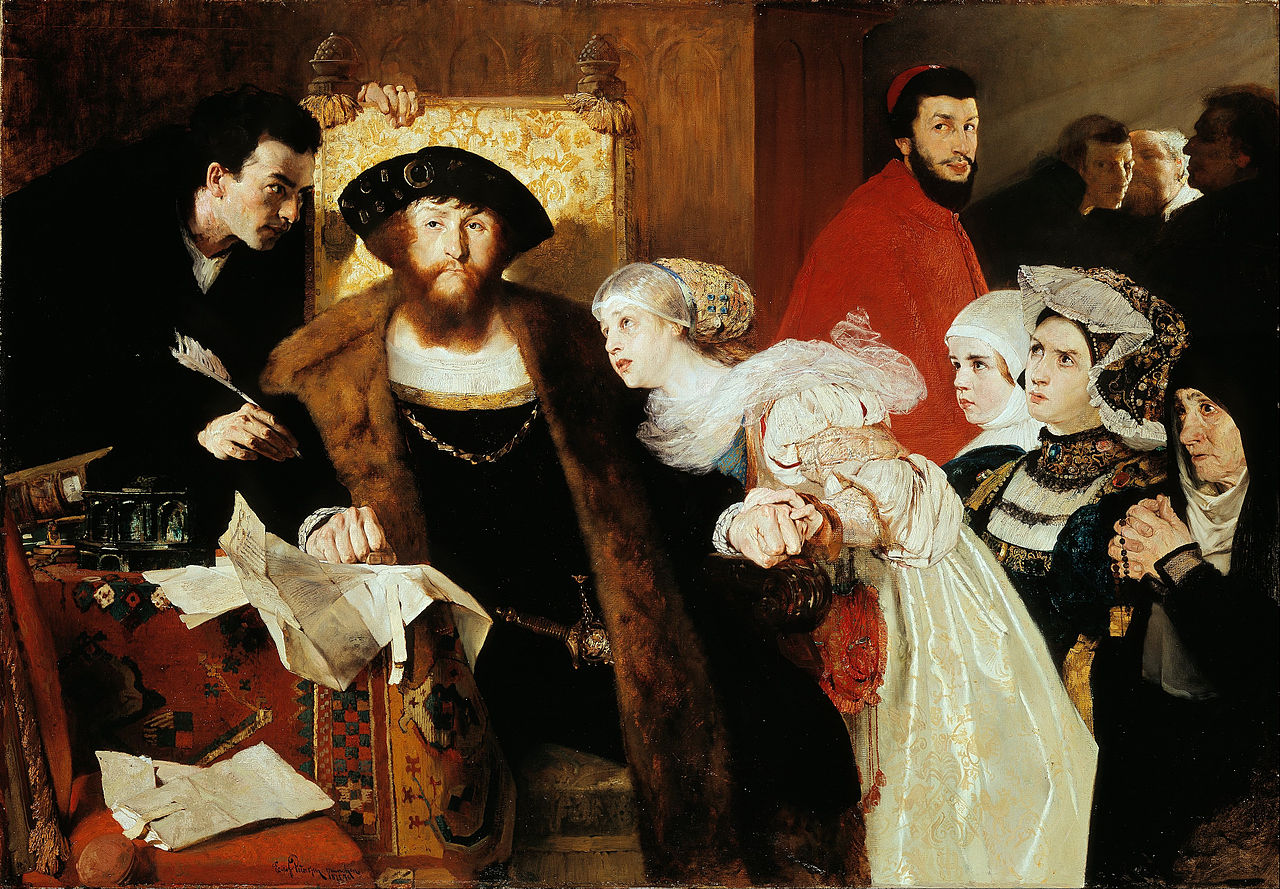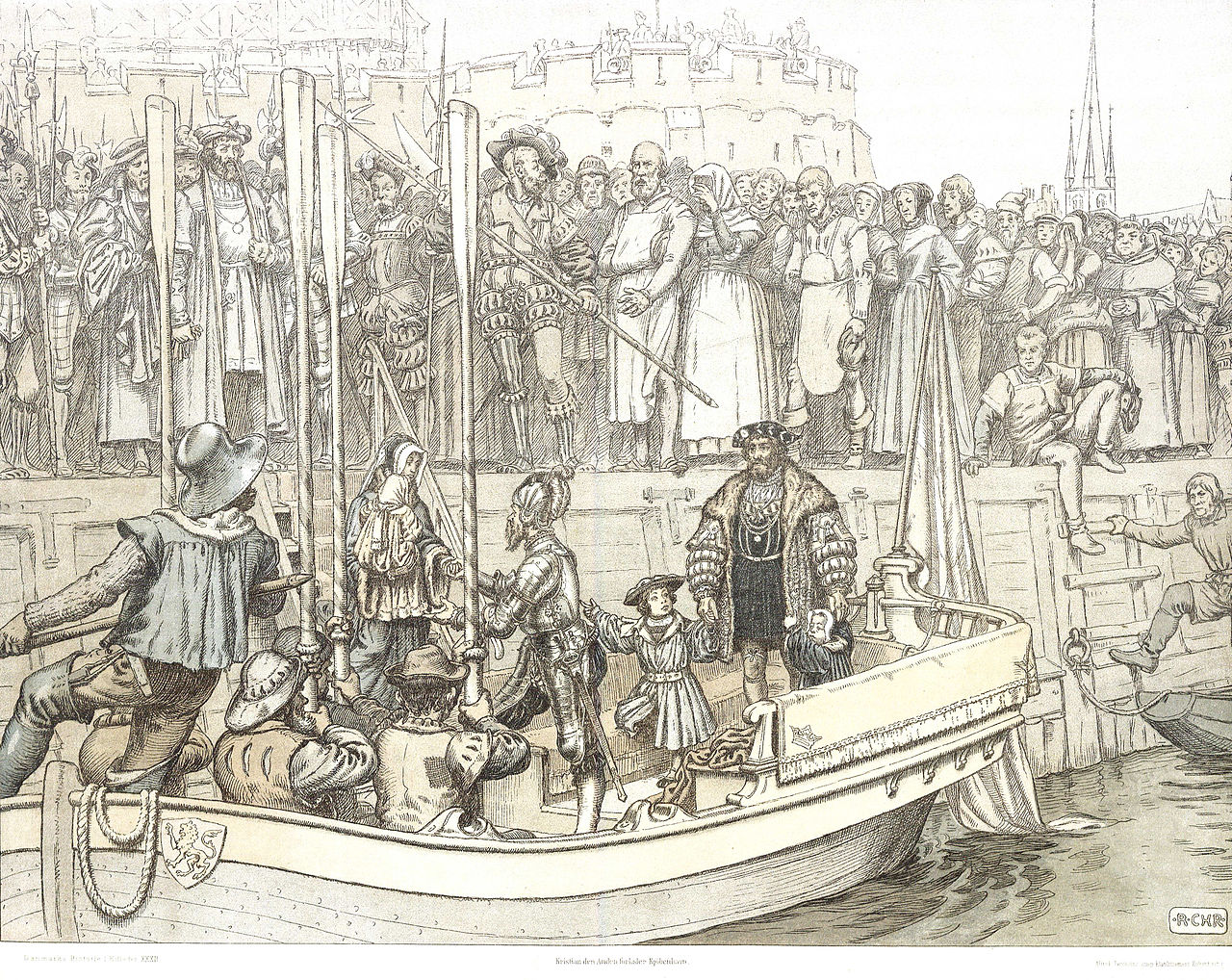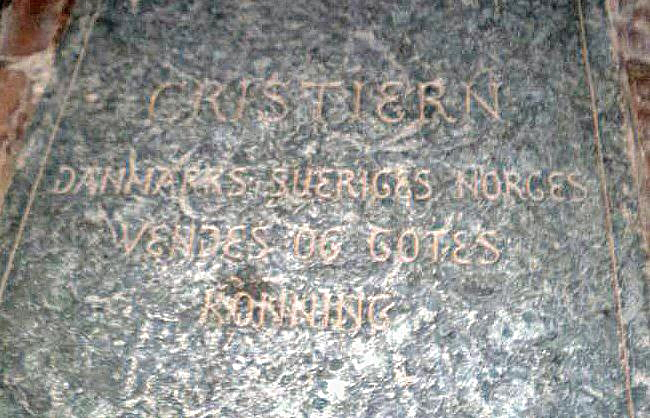by Susan Flantzer
© Unofficial Royalty 2021

Christian II, King of Denmark, Norway, and Sweden; Credit – Wikipedia
Nicknamed Christian the Tyrant, Christian II was King of Denmark and Norway from 1513 until 1523 and also King of Sweden from 1520 until 1521. From 1513 to 1523, he was the joint ruler of the Duchies of Schleswig and Holstein with his paternal uncle Frederik, the future King Frederik I of Denmark and Norway. In 1523, Christian II was forced to abdicate and was exiled. After trying to reclaim the throne in 1531, Christian was imprisoned for the last twenty-seven years of his life.
Born in Nyborg Castle in Denmark on July 1, 1481, Christian was the third but the eldest surviving of the five sons and the third of the six children of Hans, King of Denmark, Norway, and Sweden and Christina of Saxony.
Christian had four brothers and one sister:
- Hans of Denmark (1479 – 1480), died in infancy
- Ernst of Denmark (1480 – 1500), unmarried
- Jacob of Denmark (1484 – 1566), probably Jacob the Dacian, a Danish-born Franciscan monk who worked as a missionary with the Purépecha, an indigenous people in Mexico
- Elisabeth of Denmark, Electress of Brandenburg (1485 – 1555), married Joachim I Nestor, Elector of Brandenburg, had five children
- Frans of Denmark (1497 – 1511), died as a teenager from the plague
As a sixteen-year-old, Christian took part in his father’s conquest of Sweden in 1497, and four years later, he took part in attempting to quell an uprising in Sweden that caused his father to lose the Swedish throne. After his father lost the Swedish throne in 1501, a succession of regents ruled in Sweden. In 1508, a rebellion in Norway was crushed by Christian who ruled Norway as viceroy. At this time, the monarchies of Denmark, Norway, and Sweden elected their kings. Upon his father’s death in 1513, Denmark and Norway quickly confirmed Christian as their king and Sweden remained under the rule of regents.

Christian and his mistress Dyveke Sigbritsdatter; Credit – Wikipedia
Around 1508, while visiting Norway, Christian fell in love with Dyveke Sigbritsdatter. She remained his mistress until she died in 1517. Christian needed to marry to provide for the succession and the choice of a wife fell upon Isabella of Austria, Archduchess of Austria, Infanta of Castile and Aragon from the House of Habsburg. Isabella was the daughter of Queen Juana I of Castile and Aragon and Philip, Duke of Burgundy. Isabella’s maternal grandparents were King Ferdinand II of Aragon and Queen Isabella I of Castile. Her paternal grandparents were Maximilian I, Holy Roman Emperor and Mary, Duchess of Burgundy in her own right. Isabella’s brother was the powerful Charles V, Holy Roman Emperor who was also King of Spain.

Isabella of Austria, circa 1515; Credit- Wikipedia
On July 11, 1514, one week short of her 13th birthday, Isabella was married by proxy to 23-year-old Christian II with Holy Roman Emperor Maximilian I, Isabella’s grandfather, standing in for Christian. Isabella remained in the Spanish Netherlands until the summer of 1515 when Erik Axelsson Valkendorf, Archbishop of Nidaros (in Norway) was sent to escort her to Copenhagen where Christian and Isabella were married in person on August 12, 1515. Christian refused to end his relationship with his mistress Dyveke Sigbritsdatter. This created tension between Christian and his brother-in-law, the future Holy Roman Emperor Charles V, who demanded that Dyveke Sigbritsdatter be sent away, only to get a refusal from Christian.

Three children of Christian II, Dorothea, Hans, and Christina; Credit – Wikipedia
Christian II and Isabella had five children but only three survived infancy and then only two daughters reached adulthood:
-
- Hans of Denmark (1518 – 1532), died at age fourteen
- Philip Ferdinand of Denmark (born and died 1519), twin of Maximilian, died shortly after birth
- Maximilian of Denmark (1519 – 1520), twin of Philip Ferdinand, died in infancy
- Dorothea of Denmark, Electress Palatine (1520 – 1580), married Friedrich II, Elector Palatine, no children
- Christina of Denmark, Duchess of Milan, Duchess of Lorraine (1521 – 1590), married (1) Francesco II Sforza, Duke of Milan, no children (2) François I, Duke of Lorraine, had one son and two daughters

Christian II signing the death warrant of Torben Oxe; Credit – Wikipedia
When Christian II’s mistress Dyveke Sigbritsdatter died in 1517, Christian believed she had been poisoned by Torben Oxe, a Danish nobleman. Torben Oxe was tried and acquitted by the Danish State Council. However, Christian did not accept the verdict and had Oxe indicted by a lower justice-of-the-peace court. The verdict, as directed by King Christian II, was guilty and Torben Oxe was executed. Members of the Danish State Council strongly disapproved of what Christian had done. This act precipitated the division between the king and aristocracy that ultimately led to Christian being deposed.

King Christian II reviewing accounts with Sigbrit Willoms; Credit – Wikipedia
To make matters worse for Christian II and his relationship with the aristocracy, his chief advisor was Dyveke Sigbritsdatter’s mother Sigbrit Willoms who was his de facto minister of finance. Sigbrit was from the middle class and wanted to extend the influence of the working classes. She formed her own council that competed with the Danish State Council for power. Her influence was resented by the aristocracy who blamed her for Christian favoring the working classes.
Christian II still wanted to regain the Swedish crown. In Sweden, the Regent of Sweden Sten Sture the Younger headed the anti-Danish faction, and Archbishop Gustav Trolle led the pro-Danish party. After two unsuccessful attempts in 1517 and 1518 resulting in military victories for Sweden, Christian II’s army with forces of French, German, and Scottish mercenaries was successful in 1520. On November 4, 1520, Christian was crowned King of Sweden in Storkyrkan Cathedral in Stockholm.

The Stockholm Bloodbath; Credit – Wikipedia
Three days after the coronation, Archbishop Trolle accused the followers of Sten Sture of heresy for their part in the rising against him and King Christian II. What followed is known as the Stockholm Bloodbath. It is estimated that from November 9 – 10, 1520, 82 people were either hanged or beheaded in the square outside Stockholm Palace. Instead of cementing Christian’s control of the Swedish throne, the Stockholm Bloodbath led to him losing the Swedish throne. The remaining Swedish nobility, disgusted by the bloodbath, rose against Christian. On August 23, 1521, Christian was deposed with Gustav Vasa‘s election as Regent of Sweden. On June 6, 1523, Gustav Vasa was elected King of Sweden, the first monarch of the Swedish House of Vasa.

Christian leaving Copenhagen, Denmark in 1523 with his wife Isabella and their children Hans, Dorothea, and Christina; Credit – Wikipedia
By 1523, the Danes also had enough of Christian II and a rebellion started. Christian was forced to abdicate by the Danish nobles and his paternal uncle Frederik, Duke of Schleswig and Holstein was offered the crown on January 20, 1523. Frederik’s army gained control over most of Denmark during the spring. On April 13, 1523, Christian, his wife Isabella, and their children left Denmark to live in the Spanish Netherlands, a territory of Isabella’s brother Charles V, Holy Roman Emperor. Both Christian and Isabella were interested in the teachings of Martin Luther. Isabella never converted but it appears that Christian did convert for a while. On January 19, 1526, Isabella died after a long illness at the age of 24.
Eventually, Christian reverted to Catholicism and reconciled with Charles V, Holy Roman Emperor. In November 1531, Christian took a fleet of ships to try to reclaim Norway but was unsuccessful. He accepted a promise of safe conduct from his uncle Fredrick I, King of Denmark and Norway. However, Frederik did not keep his promise. Instead, Christian was imprisoned for the last twenty-seven years of his life, first in Sønderborg Castle and then at Kalundborg Castle (link Danish). While in captivity, Christian was treated like a nobleman. He was allowed to host parties, go hunting, and wander freely as long as he did not go beyond the town boundaries.
The former Christian II, King of Denmark, Norway, and Sweden died at Kalundborg Castle on January 25, 1559, aged 77. Christian’s first cousin, King Christian III who had succeeded his father King Frederik I, had died earlier in January. The new king, Frederik II, Christian III’s son, ordered the former king to be buried with royal honors. Christian II was buried with his parents in the Gråbrødre Church of the Franciscan monastery in Odense, Denmark. In 1807, the former Franciscan church was demolished, and the remains of King Christian II and his parents were transferred to St. Canute’s Cathedral, also in Odense, Denmark. Christian’s wife Isabella was originally buried in St. Peter’s Abbey in Ghent, Spanish Netherlands, now in Belgium. In 1883, thanks to the efforts of the Danish government, Isabella’s remains and those of her son Hans were transferred to St. Canute’s Cathedral.

Grave of Christian II; Credit – Wikipedia
This article is the intellectual property of Unofficial Royalty and is NOT TO BE COPIED, EDITED, OR POSTED IN ANY FORM ON ANOTHER WEBSITE under any circumstances. It is permissible to use a link that directs to Unofficial Royalty.
Kingdom of Denmark Resources at Unofficial Royalty
- Kingdom of Denmark Index
- Danish Orders and Honours
- Danish Royal Burial Sites: House of Oldenburg, 1448 – 1863
- Danish Royal Burial Sites: House of Schleswig-Holstein-Sonderburg-Glücksburg, 1863 – present
- Danish Royal Christenings
- Danish Royal Dates
- Danish Royal Residences
- Danish Royal Weddings
- Line of Succession to the Danish Throne
- Profiles of the Danish Royal Family
Works Cited
- Da.wikipedia.org. 2020. Christian 2.. [online] Available at: <https://da.wikipedia.org/wiki/Christian_2.> [Accessed 21 December 2020].
- Da.wikipedia.org. 2020. Elisabeth Af Habsburg. [online] Available at: <https://da.wikipedia.org/wiki/Elisabeth_af_Habsburg> [Accessed 21 December 2020].
- En.wikipedia.org. 2020. Christian II Of Denmark. [online] Available at: <https://en.wikipedia.org/wiki/Christian_II_of_Denmark> [Accessed 21 December 2020].
- En.wikipedia.org. 2020. Isabella Of Austria. [online] Available at: <https://en.wikipedia.org/wiki/Isabella_of_Austria> [Accessed 21 December 2020].
- En.wikipedia.org. 2020. Stockholm Bloodbath. [online] Available at: <https://en.wikipedia.org/wiki/Stockholm_Bloodbath> [Accessed 21 December 2020].
